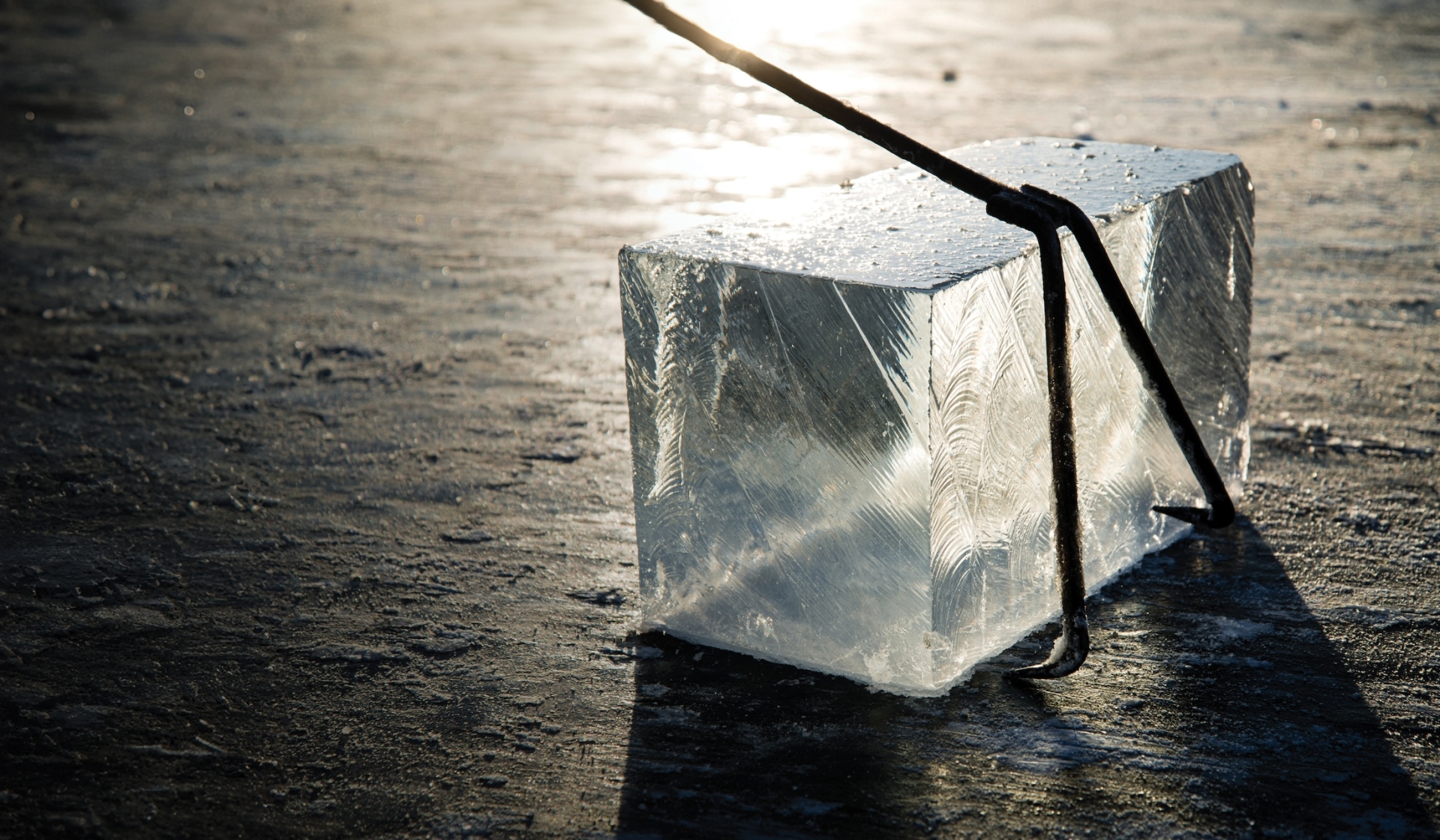Modern Ice Age
A longtime American obsession, luxury ice is cooler, colder, and classier than ever.
The American love affair with ice goes way back. All the way back to the last Ice Age, in fact, when some of the earliest Americans crossed the Bering Strait into Alaska over 13,000 years ago. Since then, we’ve found plenty of uses for ice, from skating, to sculpture, to frosty treats. Lately, the cultural obsession with ice has reached new heights, with ice engineers, craft cocktail creators, and artists all getting in on the game. Thanks to a combination of science and creativity, modern luxury is increasingly being served on the rocks.
THE ICE KING COMETH
People have been harvesting ice from frozen lakes and ponds for millenia, adding it to drinks and even making ice cream. But for almost as long as they’ve enjoyed ice, people have puzzled over how to keep it from disappearing. As far back as 2000 BCE, the ancient Sumerian civilizations devised earthen containers to keep ice frozen for months at a time, and Persian icehouses, called “yakchal,” have been in use for at least 2000 years.
Ice’s fickle tendency to melt, however, meant that year-round ice long remained a treat only for the powerful and wealthy: the Roman emperor Nero was allegedly so obsessed with ice, he sent people to fetch it from the tops of mountains so he could cool his wine. That all changed in the early 1800s, when an enterprising New Englander found a way to bring ice to the masses.
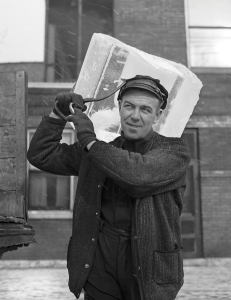
Before refrigeration, delivery men used tongs to bring ice to households in the 1930s.
In 1816, Frederic Tudor cut thousands of pounds of ice from his family’s lake in Wenham, Massachusetts and loaded them onto a ship. He packed the blocks closely together and covered them in sawdust, a novel method that kept them from melting during the journey. Then, over protests from his skeptical friends and family, Tudor set sail for Havana, confident he would find people to buy his frozen water.
Tudor’s marketing scheme began, however improbably, with cocktails. In Cuba, he gave bemused bartenders free blocks of ice and showed them how to use it in their drinks. “As it turned out, customers loved ice,” says Dr. Amy Brady, author of Ice: From Mixed Drinks to Skating Rinks. “Bartenders kept coming back to him for more and more ice.” Tudor began turning a profit, and was soon traveling from island to island, transforming every destination into an “ice city.”
After winning over the Caribbean, he brought ice to New Orleans, where bartenders whipped the novelty ingredient into some of the most enduring cocktails enjoyed today. “Ice was one more element for bold mixologists to experiment with,” says Brady. “It didn’t take them long to figure out that different shapes and sizes of ice could be used to change the flavors of their drinks.”
From there, ice became a cultural phenomenon, blooming a bevy of iced drinks and popularizing sweet treats, like ice cream and the palate-cleansing intermezzi, known as sorbet. But with no way to manufacture it, all the world’s ice had to be cut by hand from frozen lakes, and that made it expensive. “People called it ‘white gold,’” Brady says. “It was definitely associated with luxury.”
Tudor, a shrewd businessman who was dubbed the “Ice King” of his era, seized upon that association as part of his marketing strategy. Ice—ephemeral, glittering, expensive—was something to be coveted. Elegant cocktail bars and ice cream parlors helped establish the luxury appeal of ice. Tudor’s exported ice, which sailed as far as India, became a source of American pride, proof that the fledgling country led the world in technical innovation and high-end glamour. Ice eventually caught on across the globe, but the American obsession with ice has always been in a class of its own–a fact Americans often discover when they attempt to order ice water at European restaurants.
EVERYBODY WANTS TO BE THE ICEMAN
Frederic Tudor dominated the ice industry for a surprisingly long time, but the entire enterprise of shipping ice from Northern Lakes ultimately gave way to manufactured ice, which allowed ice to be created anywhere in the world and drove the cost of ice down dramatically. By the 1920s, almost every family in America had an icebox, restocked every week by the iceman.
The iceman became a mythic character in American culture: brawny, reliable, and welcomed into the housewife’s kitchen, where he was often offered a glass of lemonade. Those unsupervised visits sparked dozens of bawdy jokes and songs: “From every girl a kiss is his price,” went the 1899 song How’d You Like to be The Iceman. “If he gets no kiss, there’ll be no ice!” Electricity revolutionized the ice trade yet again, bringing refrigeration and freezing into most American homes and ending the era of the iceman. By 1955, 80% of American homes had a refrigerator with a freezer.
The great democratization of ice in some ways marked its demise—in quality, at least. If you’ve ever filled a glass with cloudy ice from an automatic ice machine, you understand the issue. Automatic ice machines made it easy to fill a water glass or stock a bar with pre-made cubes, but it also conditioned us to a humdrum life on the rocks.
Ice, however, retained somewhat of its luxury status through dramatic ice sculptures—especially the iconic swan—that graced tables at weddings and holiday parties, but for most Americans, ice was an everyday commodity, not a work of art. That might have been the end of the story, but thanks to a new generation of artists, bartenders, and entrepreneurs, ice is, once again, very cool.
NICE ICE, BABY
For Shintaro Okamoto, ice is a family affair. His father was an ice sculptor, and Okamoto, who grew up in Alaska, inherited his passion. “I always have to add that not all Alaskans play with ice, but I did,” he jokes. After art school, he partnered with his father to venture into novel territory: artisanal designer ice.
Twenty years later, Okamoto Custom Ice Studio, based in New York, is one of the country’s premier purveyors of hand-crafted luxury ice. Okamoto’s ice artists create eye-catching ice sculptures, branded cubes, and trapped-in-ice displays featuring everything from fresh orchids to sneakers. They’ve collaborated with countless brands to build glamorous works of art as beautiful as they are ephemeral. “People are awed by the amount of detail we put into this work that is literally disappearing before their eyes,” Okamoto says. “I find it fascinating as an artist to work with something that’s ever-changing.”
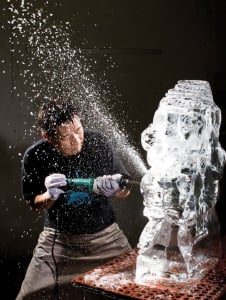 Ice carvers at Okamoto Studio collaborate with high-end brands and artists to create captivating installations and performances out of crystal-clear ice.
Ice carvers at Okamoto Studio collaborate with high-end brands and artists to create captivating installations and performances out of crystal-clear ice.
Okamoto Studios is at the leading edge of the modern ice movement, which has transformed the everyday material into a genuine work of art. Innovations in ice manufacturing have revolutionized the industry, creating clear-as-glass blocks of ice from which artists can carve everything from gold-flecked ice cubes to life-sized Buddha sculptures.
Perfect clarity has not only unlocked ice as a limitless art form, it’s also transformed the cocktail scene. “People were freezing water in sheet pans and breaking it with hammers,” Okamoto recalls, noting that ice studios have helped bar owners launch “the rebirth of the new American cocktail world.” High-end bars and restaurants are increasingly partnering with ice purveyors, who provide hand-cut cubes customized for a specific beverage service.
“Consumers instantly notice the ‘Instagrammable’ difference in visual quality between our ice and regular ice,” says Kara Wylie, VP of sales at Fat Ice, an Austin-based company that provides custom ice to bars and restaurants in multiple states. But quality ice is about more than appearances, Wylie notes: “When you add ice to a beverage, the integrity of the taste profile begins to change.” Fat Ice’s multi-step method increases the density of the ice cube, so that it melts more slowly and doesn’t dilute the drink quality. From branded stamps to frozen flower interiors to custom-sized spheres and cubes, high-end ice companies like Fat Ice are helping bartenders and cocktail designers up the ante on luxury beverages.
The American fondness for ice is only increasing: a 2020 poll commissioned by Bosch found that 51% of Americans consider themselves “ice-obsessed,” consuming over 400 pounds of ice a year. Those eye-catching numbers have brought the ice revolution into the home, with appliance brands rolling out refrigerators with craft-ice machines and home goods purveyors offering artisanal cocktail ice makers. As demand grows, engineers are developing methods to create ice more sustainably, transitioning to energy-efficient methods like vapor absorption and atomic crystals for freezing and refrigeration. “These ideas will really revolutionize the cooling industry,” explains Dr. Brady, author of Ice, who notes that such innovation will help meet Americans’ love for ice without increased burden on the planet.
From crystal clear ice cubes to jaw-dropping ice towers, we are living in a modern ice age, where the traditions of ancient civilizations meet our own technological creativity. Today, world-class ice may be only as far away as the push of a button, but the journey it took to get there stretches back far into our own human history.
The substance itself may come and go, but our love for ice stays constant, year after year.
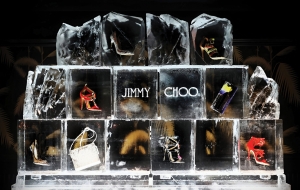
The Frozen In Ice collection by Okamoto Studio in collaboration with Jimmy Choo.
COASTAL COOL
Nic Wallace knows a thing or two about cocktails. As Resort Bars and Spirits Manager at Sea Island, he oversees all the cocktail and spirits programs across the resort. When it comes to crafting superlative drinks, Wallace knows that every detail is critical—including ice. “It’s interesting that people take ice for granted when barely 70 years ago, it was just unheard of in the modern cocktail bar,” says Wallace. “But these days, ice is a huge part of what we do.”
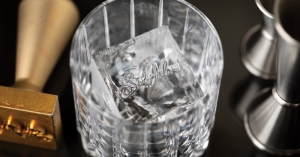
Custom hand-cut ice cube stamped with Sea Island.
Sea Island produces its own ice cubes for everyday use, but to garnish the resort’s fine-crafted cocktails and spirits, the resort turns to the ice professionals. The Gainesville Ice Doctor delivers a bi-weekly shipment of custom hand-cut cubes, spheres, and other ice, designed and cut expressly for Sea Island beverage menus.
Gainesville Ice Doctor founder Andrew Amron saw an opportunity to help beverage masters perfect their ice product. “I wanted to make flawless, perfect ice that bartenders wouldn’t have to do anything with except put it in a glass,” he explains. A former history professor—hence the “ice doctor”—Amron’s company uses a slow-freezing method to create ultra-clear ice and customizes cuts to suit each client’s unique needs. Everything is hand-cut in the freezer, ensuring that each ice cube is perfectly shaped and uniform, and delivered to clients glass-ready. “The whole ice industry is jumping off,” Amron says. “Nine years ago, none of this was here.”
Gainesville Ice Doctor now furnishes Sea Island with luxury ice for its sixteen beverage outlets. They also provide custom stamped logos on Sea Island cubes, which are featured in drinks throughout the resort. That’s helped elevate cocktails and spirits across the resort, says Wallace, who’s dedicated to creating unparalleled beverage experiences for guests. “The discerning luxury traveler has seen everything at this point, so we want to create something new for them,” he notes. “That means everything is very intentionally thought through.”
For corporate retreats and other group events, Sea Island can hand stamp company’s logos on their large-format ice cubes, providing an extra touch of personalization to gatherings. It’s elements like these, that make a visit to Sea Island something beyond the ordinary. “What separates the good from the great,” Wallace says, “is really in the details.”




